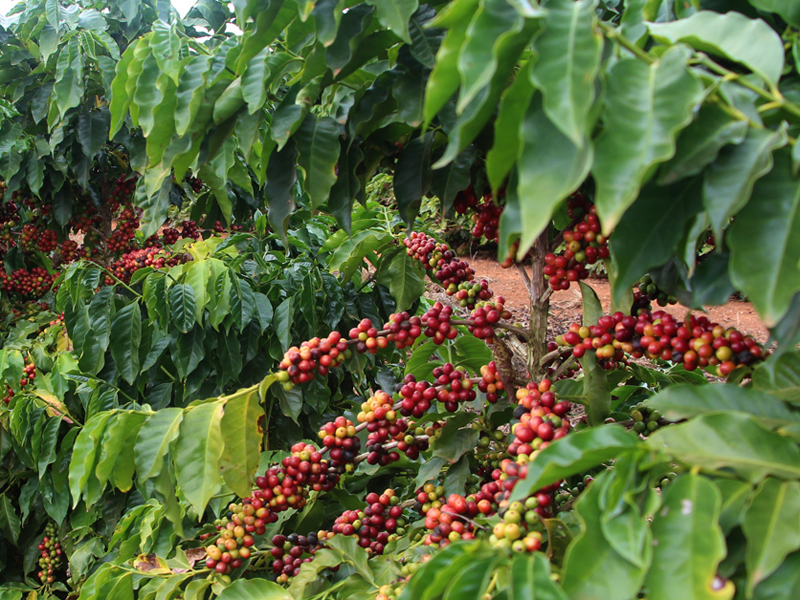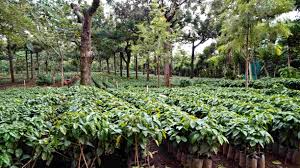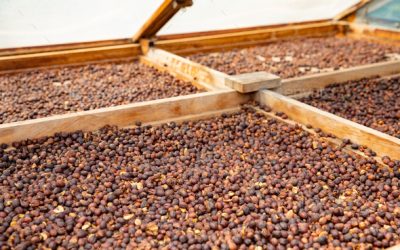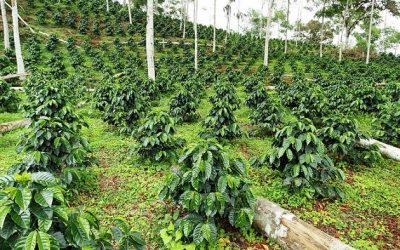A coffee plant and its management.

An understanding of the coffee plant, its make up and how it grows is essential to understanding how to manage the coffee tree. Management, like the growing environment and the variety planted, has a very big influence on coffee quality and yield.
The shape of the coffee plant varies depending on the species and variety. All coffee trees consist of an upright main shoot (trunk) with primary, secondary and tertiary lateral branches. The plant has a main taproot, lateral and small feeder roots. The coffee tree produces two distinct types of branches:
Vertical or orthotropic branches have nodes at a regular distance and carry opposite leaves. These branches are called suckers at the developing stage and stems at the final stage. Each leaf pair is cross-positioned to the next leaf pair. In the axil of each leaf, are four to six serial buds and directly above them, one slightly bigger bud called ‘extra-axillary bud’ because of its relatively distant position. This extra-axillary bud develops into a plagiotropic or lateral, horizontal branch.
Lateral or plagiotropic branches grow almost at right angles from the main stems. No other bud in the same axil can grow into a lateral branch, which means that if such a branch is cut off, no lateral regeneration can occur on the node of a main vertical stem. Laterals are usually called primaries. Each serial bud on a primary can develop into an inflorescence (flower) or into a secondary branch, which has a similar structure to the primary branch with serial buds that develop either into flowers or tertiary branches. If a secondary branch is cut or removed, another secondary on the same axil can replace it, so regeneration of secondaries on primaries is possible.
Each branch has a terminal bud. In the nodes are a fixed number of buds that have the potential to form 40 fruits depending mainly on the species and nutritional conditions. At each leaf node there are 5 buds each with 4 flowers, which may form 20 fruits.
The white flowers appear in small bunches at the nodes. After pollination, a fruit develops into a cherry about 10 to 15 mm long containing two seeds (the coffee beans). Technically, the flowers form on the one-year-old wood that is only slightly hardened. The fruits comprise pulp (coloured skin and a fleshy mesocarp called mucilage), then parchment, then the silverskin (seed coat) and finally the coffee bean.
The root system
The role of the root system is to ensure that the plant is firmly anchored in the soil and to take up a supply of water and minerals. The root system (Figure 7) consists of: a short taproot (40 to 60 cm) long; vertical, coaxial roots which are often very long (particularly in light soils) lateral roots with numerous absorbing root hairs, particularly in the upper, humus-bearing layer (30 cm)
Root system
It is necessary to stress the importance of growing techniques (pricking out in nurseries, weeding, mulching, irrigation and planting layouts) on the distribution and function of the roots. The first three years are critical for the root system development when it is vital that plants are well supplied with nitrogen, phosphorous, calcium, magnesium and sulphur.
Phenology (Crop cycle)
The phenological cycle chart on page 70 indicates the timings for key management activities in relation to the various development stages, for example, growth, flowering, fruiting.
The phenology of the coffee plant refers to the physical and physiological developmental stages of the coffee plant throughout the year. Phenology is often referred to as the crop cycle or the phenological cycle of the plant.
Coffee, like all plants responds to the changing environment (temperature, rainfall, drought, day length) in which it grows as influenced by the seasons. As the seasons change, the coffee tree switches from vegetative (root and shoot growth) to reproductive growth and as the plant grows, it flowers, sets fruit, matures the fruit and is ready for harvest and re-growth for the next cycle.
The phenological cycle gives excellent indicators of when to fertilise, irrigate, withhold water, prune, take leaf and soil analyses, check for pests and diseases and apply controls for them. Timing is very important when using these practices to optimise production from the coffee tree.


